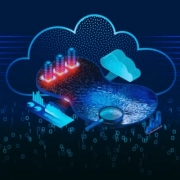DevOps Excellence with IaC: Terraform vs CloudFormation vs ARM
Key Takeaways:
- IaC is the linchpin of modern DevOps maturity—manual infrastructure management is no longer sustainable.
- Terraform = multi-cloud agility; CloudFormation = AWS-native depth; ARM = Azure-native alignment.
- The right IaC tool depends on cloud strategy, compliance mandates, and scalability goals—there’s no one-size-fits-all.
For modern enterprises, every minute of downtime translates directly into lost revenue, frustrated customers, and serious compliance risks. Yet, many organizations still manage infrastructure manually, relying on scripts and ad-hoc fixes that can’t keep pace with modern demands. The result? Configuration drift, inconsistent environments, and risky delays in scaling critical systems.
This is where DevOps services powered by Infrastructure as Code (IaC) come into play. Instead of manually configuring servers or cloud resources, IaC lets teams define infrastructure in reusable templates making it predictable, secure, and easy to scale. For technology leaders in fintech, SaaS, insurance, lending, and payments, IaC isn’t just a nice-to-have—it’s a must-have to reduce downtime, simplify governance, and accelerate delivery.
But with multiple IaC tools available, how do enterprises decide which one to use? In this blog, we’ll compare Terraform AWS, AWS CloudFormation, and Azure Resource Manager (ARM) three of the most widely adopted tools shaping modern DevOps practices. We’ll break down how each tool helps enterprises align with IaC best practices, streamline DevOps pipelines, and enable secure, scalable cloud infrastructure.
At Sigma Infosolutions, our goal is to help enterprises choose the right IaC tool to match their cloud strategy. By codifying infrastructure through the right platform, organizations unlock faster deployments, stronger compliance, and a pathway to true DevOps excellence.
Why IaC is the Backbone of DevOps Excellence
At its core, Infrastructure as Code (IaC) is exactly what it sounds like—treating infrastructure the same way developers treat application code. Instead of clicking through cloud dashboards or manually configuring servers, teams write code-like templates that define the desired state of their infrastructure. This means every environment—from dev to staging to production—can be created consistently, repeatably, and on demand.
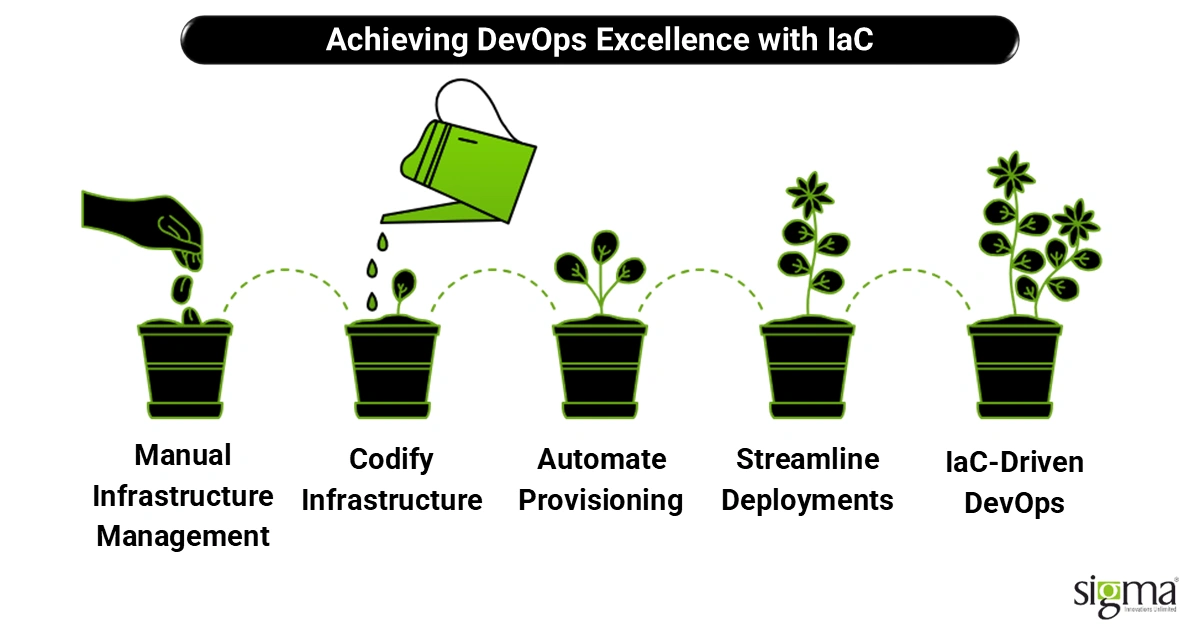
For enterprises under constant pressure to move fast without breaking things, IaC is a game-changer. Some of the key benefits include:
- Consistency & repeatability: No more “it works on my machine” issues—environments spin up the same way every time.
- Reduced configuration drift: Automated provisioning ensures updates are applied uniformly across systems.
- Faster deployments: IaC shrinks infrastructure setup from days to minutes, keeping release cycles on schedule.
- Improved compliance & auditability: Codified infrastructure provides an auditable trail, making it easier to meet regulatory requirements.
The adoption numbers back this up. Research insights suggest that over 72% of enterprises now leverage IaC to streamline cloud operations, and companies using IaC-driven DevOps pipelines see 40% faster release cycles with significantly lower downtime. These stats highlight why IaC isn’t just a tool—it’s a pillar of modern DevOps practices.
At Sigma, we embed IaC into our DevOps services, combining tools like Terraform AWS, CloudFormation, and Azure Resource Manager with automation-first strategies. The result? Enterprises get secure, scalable, and compliant infrastructure without the risks of manual management—helping them move confidently toward DevOps excellence.
DevOps Pain Points in Enterprise Sectors
For technology leaders, the pressure to deliver reliable, compliant, and scalable digital platforms is relentless. Yet, many still rely on manual infrastructure management, which simply can’t keep up with enterprise demands.
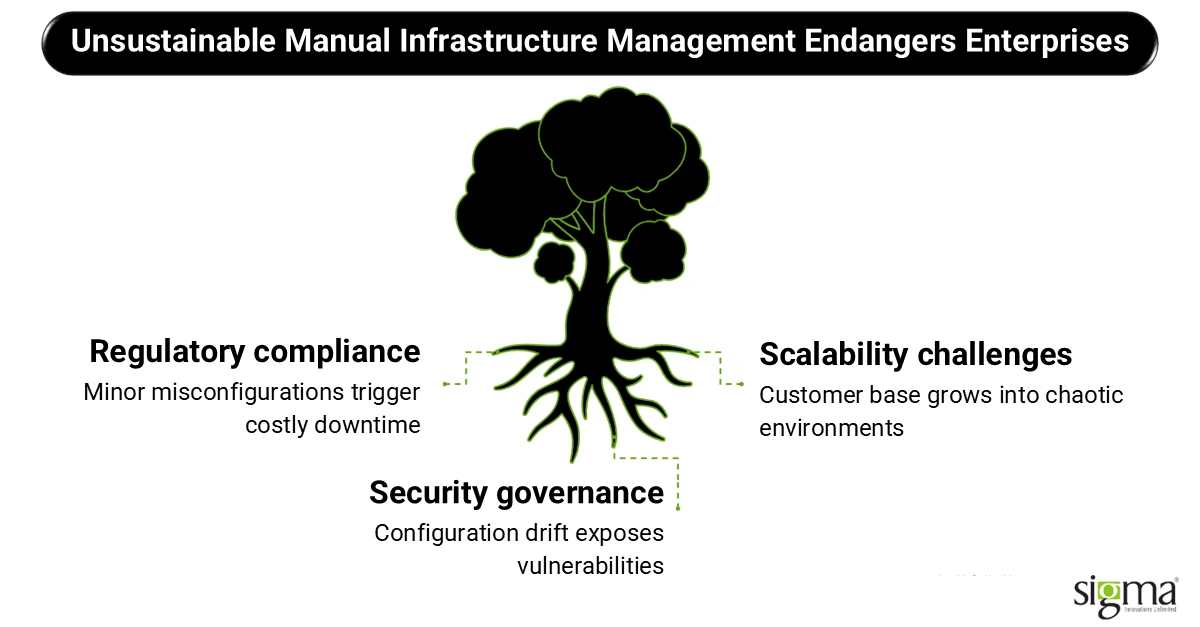
- Fintech companies face strict regulatory compliance and require near-100% uptime. Even minor misconfigurations can trigger costly downtime or compliance breaches.
- SaaS providers grapple with scalability challenges and multi-cloud complexity. As their customer base grows, so does the need for environments that can scale seamlessly without spiraling into chaos.
- Insurance and payment companies operate in highly sensitive ecosystems where security, governance, and cost optimization are non-negotiable. A single drift in configuration can expose vulnerabilities or inflate costs overnight.
Real-world examples abound:Major service outages often trace back to manual errors—an engineer forgetting a setting, a script applied inconsistently, or a missed patch leading to cascading failures. These mistakes aren’t just inconvenient; they erode customer trust and can result in compliance penalties.
This is why manual infrastructure management is no longer sustainable for enterprises. IaC infrastructure as code offers the answer—automating provisioning, enforcing governance policies, and ensuring that every environment is secure, repeatable, and audit-ready. By integrating tools like Terraform AWS, AWS CloudFormation, and Azure Resource Manager, organizations eliminate drift, boost uptime, and finally align infrastructure with modern DevOps practices.
Want to know why the C-suite can’t afford to overlook microservices-based app development? Dive deeper here!
IaC Tool Landscape: A Quick Overview
The world of Infrastructure as Code (IaC) has expanded rapidly, giving enterprises a variety of tools to choose from. Popular options include Terraform, AWS CloudFormation, Azure Resource Manager (ARM), and newer players like Pulumi that bring modern programming languages into the mix. Each tool has its own strengths, but the real challenge for technology leaders is choosing the one that best aligns with their DevOps services strategy, cloud provider, and compliance needs.
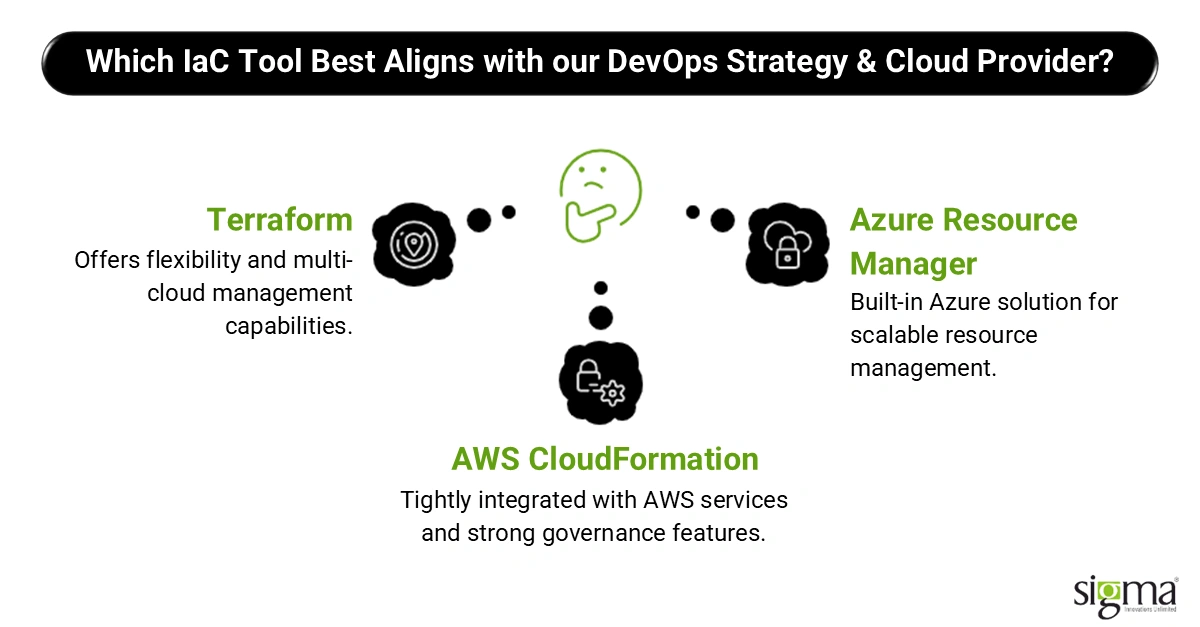
For enterprises running workloads on AWS and Azure, the three most widely adopted options are:
- Terraform AWS: A cloud-agnostic tool developed by HashiCorp, known for its flexibility, large provider ecosystem, and ability to manage multi-cloud or hybrid environments with ease.
- AWS CloudFormation: Amazon’s native IaC offering, tightly integrated with AWS services and purpose-built for deploying AWS CloudFormation stacks and templates with strong governance features.
- Azure Resource Manager (ARM): Microsoft Azure’s built-in IaC solution, leveraging Azure ARM templates for automation to provision, manage, and monitor resources at scale.
These three platforms have emerged as the go-to solutions for enterprises seeking to move beyond manual infrastructure management and embrace modern DevOps practices. They not only enable automation and consistency but also play a central role in building resilient DevOps pipelines.
In the sections ahead, we’ll dive deeper into Terraform AWS, CloudFormation, and Azure Resource Manager, comparing their features, use cases, and suitability for enterprises in fintech, SaaS, payments, and insurance.
Deep Dive: Terraform
When it comes to Infrastructure as Code (IaC), Terraform AWS by HashiCorp has become the tool of choice for enterprises aiming to unify infrastructure management across multiple cloud providers. Built as an open-source, declarative platform, Terraform uses HashiCorp Configuration Language (HCL) to define infrastructure in a way that’s modular, reusable, and easy to understand—even for large, distributed teams.
Key Strengths of Terraform
- Cloud-agnostic: Unlike native tools tied to a single provider, Terraform works across AWS, Azure, Google Cloud, and even on-premises systems—making it ideal for enterprises with hybrid or multi-cloud strategies.
- Rich provider ecosystem: With hundreds of providers, Terraform can manage not just compute and storage but also networking, SaaS integrations, and third-party services.
- Modular & reusable code: HCL encourages teams to write clean, reusable modules, speeding up deployments and reducing duplication.
- Strong community & integrations: Backed by HashiCorp and an active open-source community, Terraform integrates seamlessly into DevOps pipelines and CI/CD workflows.
Limitations to Consider
Terraform isn’t without challenges. Managing state files can get tricky, especially in large environments where multiple teams are provisioning resources simultaneously. Enterprises also need to invest in security best practices—like remote state storage and access controls—to prevent accidental exposure of sensitive infrastructure data.
Enterprise Use Cases
For enterprises pursuing modern DevOps practices, Terraform shines in scenarios involving hybrid or multi-cloud deployments. Whether it’s a fintech company ensuring compliance across AWS and Azure, or a SaaS provider scaling workloads across multiple regions, Terraform enables consistency without vendor lock-in.
Adoption numbers underscore its momentum: according to the World Journal of Advanced Research and Reviews, over 70% of enterprises exploring IaC best practices have adopted or are actively using Terraform in production. That makes it not just a tool, but a cornerstone of enterprise DevOps services.
Deep Dive: AWS CloudFormation
For enterprises that run heavily on Amazon Web Services, AWS CloudFormation is often the first choice for IaC infrastructure as code. As the native IaC solution from AWS, it allows technology teams to model and provision resources using CloudFormation stacks and templates, ensuring that infrastructure is defined, versioned, and deployed consistently across environments.
Key Strengths of CloudFormation
- Deep AWS service integration: Since it’s built and maintained by AWS, CloudFormation supports nearly every AWS service from day one, making it highly reliable for teams already committed to the AWS ecosystem.
- Managed state handling: Unlike Terraform, where state management requires extra setup, CloudFormation automatically handles state within AWS, reducing operational overhead.
- Strong governance with IAM policies: CloudFormation integrates natively with AWS Identity and Access Management (IAM), enabling fine-grained control over who can deploy or modify infrastructure—critical for industries with strict compliance needs.
Limitations to Consider
- AWS-only: CloudFormation is locked to AWS, which limits flexibility for enterprises exploring multi-cloud or hybrid cloud strategies.
- YAML/JSON complexity: Writing and maintaining large YAML or JSON templates can be cumbersome, especially for teams managing dozens of microservices.
- Slower innovation pace: Compared to Terraform AWS, CloudFormation updates and community-driven extensions often arrive later.
Enterprise Use Cases
For enterprises deeply invested in AWS—such as fintechs requiring high uptime, strong compliance, and automated recovery—CloudFormation offers a secure, integrated path to infrastructure automation. A payments provider, for example, can use CloudFormation to spin up disaster recovery environments, enforce governance rules, and reduce manual errors that could otherwise compromise availability or compliance.
By embedding CloudFormation into modern DevOps practices, AWS-heavy organizations gain tighter control over infrastructure provisioning and security, while still aligning with DevOps services that prioritize scalability and resilience.
Curious how AWS cloud solutions enable enterprise-grade data lakes? Check out our detailed breakdown here!
Deep Dive: Azure Resource Manager (ARM)
For organizations operating heavily in Microsoft’s cloud ecosystem, Azure Resource Manager (ARM) serves as the native framework for managing infrastructure through code. ARM allows enterprises to define, deploy, and manage Azure resources using JSON-based Azure ARM templates for automation, ensuring consistency and governance across environments.
Key Strengths of ARM
- Deep Azure integration: Because ARM is built directly into the Azure platform, it supports the full breadth of Azure services without requiring external tooling.
- RBAC + Policy for governance: ARM ties directly into Azure’s role-based access control (RBAC) and policy framework, enabling fine-grained permissions and compliance enforcement across large enterprises—crucial for regulated industries.
- Template consistency across services: ARM templates provide a standard way to model resources, ensuring predictable deployments across teams and applications.
Limitations to Consider
- Azure-only: ARM is tied exclusively to Microsoft Azure, which makes it less flexible for enterprises exploring hybrid or multi-cloud approaches.
- JSON verbosity: Large ARM templates can quickly become unwieldy and hard to manage, requiring skilled teams to maintain.
- Complexity at scale: Managing dependencies and coordinating large-scale deployments can add significant overhead.
Enterprise Use Cases
ARM is best suited for enterprises deeply invested in Azure, such as banks, insurers, or SaaS providers that prioritize governance and compliance. For example, an insurance company running multiple customer-facing apps on Azure can use ARM templates to standardize deployments, enforce policies, and cut down the risk of misconfigurations.
Evolution to Bicep
Recognizing JSON’s complexity, Microsoft introduced Bicep, a more concise and human-readable language that compiles down to ARM templates. Bicep simplifies template authoring while maintaining ARM’s governance and security strengths, making IaC more approachable for enterprise DevOps teams.
By leveraging ARM and its Bicep evolution within DevOps services, organizations gain secure, policy-driven automation that aligns with modern DevOps practices while unlocking the benefits of infrastructure as code for enterprises.
Head-to-Head Comparison: Terraform vs CloudFormation vs ARM
When it comes to choosing an Infrastructure as Code (IaC) tool, there’s no single winner—each platform brings unique strengths to the table. For technology leaders in fintech, SaaS, payments, and insurance, the right choice depends on cloud strategy, compliance needs, and DevOps maturity.
Here’s a quick comparison across key enterprise factors:
| Feature | Terraform | CloudFormation | Azure Resource Manager (ARM) |
|---|---|---|---|
| Multi-cloud/hybrid support | Strong multi-cloud (AWS, Azure, GCP, on-prem) | AWS-only | Azure-only |
| Ease of use & learning curve | Moderate – HCL is intuitive, but state management adds complexity | Moderate – YAML/JSON templates can be verbose | Steeper – JSON-heavy, improved with Bicep |
| Community & ecosystem | Large open-source community, rich provider ecosystem | Strong AWS ecosystem, smaller community compared to Terraform | Backed by Microsoft, a smaller community but growing with Bicep |
| Enterprise governance & compliance | Supports policies via Sentinel + third-party integrations | Tight AWS IAM integration for fine-grained governance | Strong with RBAC + Azure Policy integration |
| Cost & licensing | Free open-source (Terraform Cloud/Enterprise adds features) | Free, included with AWS usage | Free, included with Azure usage |
| CI/CD integration | Seamless with most CI/CD & DevOps pipelines | Integrates well with AWS-native pipelines (CodePipeline) | Integrates with Azure DevOps + GitHub Actions |
| Scalability | Excellent for large, hybrid enterprises | Excellent for AWS-only enterprises | Strong for Azure-heavy enterprises |
Sigma’s Advisory POV
At Sigma Infosolutions, our experience shows that:
- Terraform AWS works best for enterprises needing multi-cloud flexibility and modularity.
- AWS CloudFormation is the safest bet for AWS-centric organizations that require deep service integration and automated state handling.
- Azure Resource Manager (with Bicep) shines for Azure-first enterprises that prioritize governance, compliance, and security at scale.
The takeaway? There’s no one-size-fits-all IaC tool. Your decision should be guided by where your enterprise runs most of its workloads, the governance model you need, and your future cloud strategy. By embedding the right IaC tool into your DevOps, Sigma helps enterprises eliminate manual risks, enforce compliance, and accelerate infrastructure automation—regardless of whether they’re all-in on AWS, Azure, or running hybrid.
Choosing the Right IaC Tool: Sigma’s Framework
With so many IaC options available, the real question for enterprise leaders isn’t which tool is the best overall, but which tool is the best fit for their unique environment. At Sigma, we guide clients through this decision using our IaC Evaluation Model, which focuses on four key dimensions:
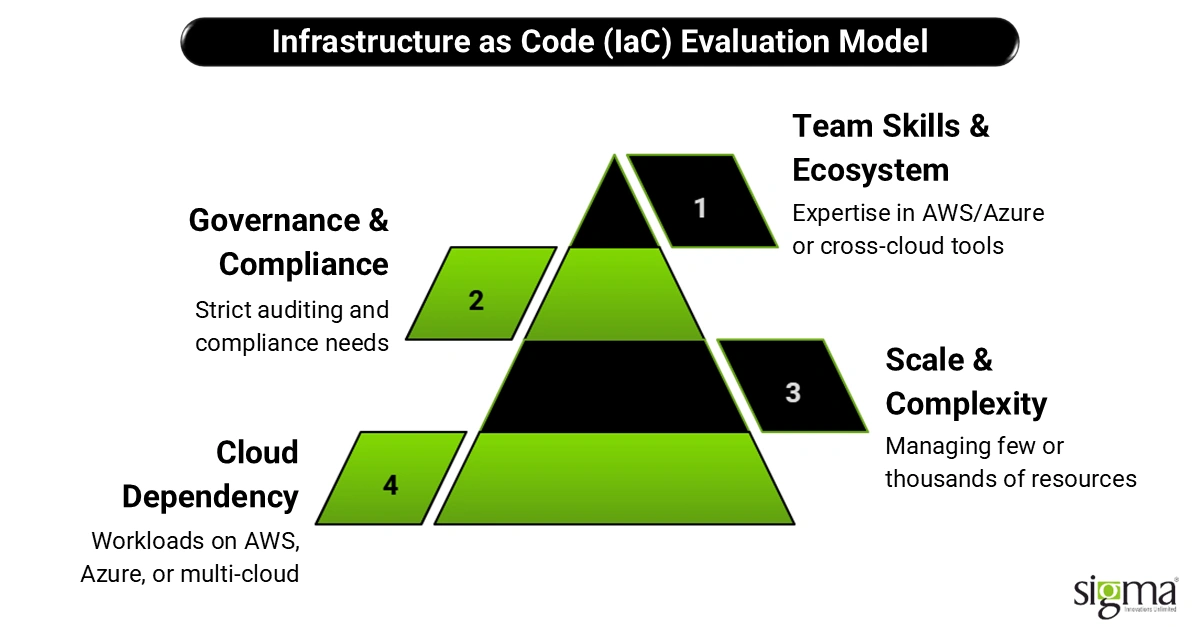
- Cloud Dependency → Where do most of your workloads run—AWS, Azure, or a multi-cloud setup?
- Scale & Complexity → Are you managing a few workloads or thousands of distributed enterprise resources?
- Governance & Compliance Needs → Does your industry require strict auditing, compliance frameworks, or fine-grained governance (common in fintech and insurance)?
- Team Skills & Ecosystem Support → Do your teams have deep AWS/Azure expertise, or do you need a cross-cloud tool that balances multiple providers?
Applying the Model
- A fintech scaling across AWS and Azure often benefits most from Terraform AWS, thanks to its multi-cloud flexibility and strong ecosystem.
- A payments company with AWS-only infrastructure gains efficiency and governance with AWS CloudFormation, leveraging native stacks and IAM policies.
- A SaaS provider scaling services on Azure aligns best with Azure Resource Manager (ARM) and Bicep, ensuring template consistency and compliance controls.
By applying this framework, Sigma ensures enterprises choose IaC tools that not only solve today’s automation challenges but also scale with tomorrow’s business growth. More than tool selection, this approach enables clients to embed modern DevOps practices into their DNA—backed by Sigma’s expertise in DevOps services, AWS Cloud Solutions, and custom development services.
Sigma’s DevOps Services: Powering IaC Excellence
Selecting the right Infrastructure as Code (IaC) tool is only the first step—real value comes from implementing it effectively across your enterprise. At Sigma, we help organizations unlock the full potential of IaC by aligning technology with business strategy.
Our DevOps services are designed to deliver secure, scalable, and automated infrastructure management:
- Assessment & Strategy → We evaluate your cloud landscape, workloads, and compliance needs to recommend the most suitable IaC tool—Terraform, CloudFormation, or Azure Resource Manager.
- IaC Implementation → From building reusable templates to automating complex environments, we streamline deployment pipelines to ensure agility and consistency.
- CI/CD Integration → We integrate IaC seamlessly into your DevOps workflows, enabling faster releases and reliable infrastructure provisioning with every code commit.
- Governance, Compliance & Security → Whether it’s a fintech needing strict audit trails or an enterprise scaling multi-cloud operations, we embed governance policies, role-based access, and security best practices at every layer.
With Sigma, enterprises don’t just adopt IaC—they gain a future-ready DevOps foundation that scales with growth, supports regulatory demands, and accelerates innovation.
Partner with Sigma Infosolutions to transform your infrastructure with secure, scalable, and automated DevOps excellence!
Final Thoughts
Infrastructure as Code (IaC) is more than just a DevOps practice—it’s the backbone of enterprise agility, resilience, and innovation. By automating infrastructure provisioning, enterprises achieve consistency, speed, and governance, all of which are essential to advancing DevOps maturity.
Each tool in the IaC ecosystem brings unique strengths: Terraform offers unmatched flexibility for multi-cloud and hybrid strategies, AWS CloudFormation delivers deep integration and governance for AWS-centric enterprises, while Azure Resource Manager (ARM) provides a powerful native approach for Azure-driven organizations. The right choice depends on your cloud strategy, compliance requirements, and team expertise.
At Sigma, we help enterprises cut through the complexity of tool selection and implementation. From strategy and adoption to governance and security, our DevOps services enable organizations to scale confidently with IaC at the core of their infrastructure.

